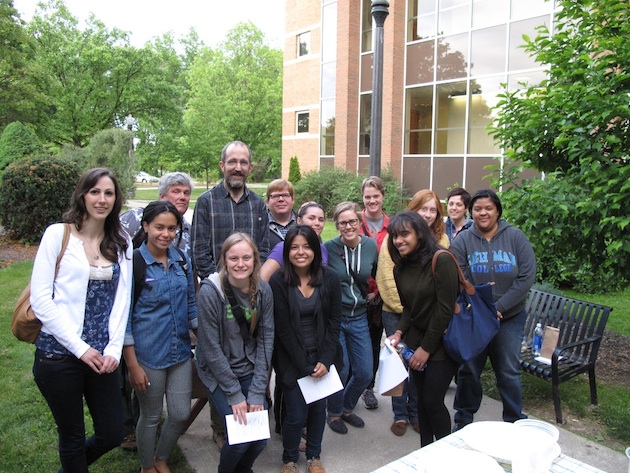Kent State University and the Holden Arboretum will use a recently awarded National Science Foundation (NSF) grant to study the impact people have on vital organisms living in places where water and land meet in Northeast Ohio.
 The NSF has awarded Kent State a grant for $345,000 for a project with Holden that provides research opportunities for undergraduate students. The grant is part of the Research Experiences for Undergraduates (REU) program, which supports active research participation by undergraduate students in any of the areas of research funded by the NSF.
The NSF has awarded Kent State a grant for $345,000 for a project with Holden that provides research opportunities for undergraduate students. The grant is part of the Research Experiences for Undergraduates (REU) program, which supports active research participation by undergraduate students in any of the areas of research funded by the NSF.
The project, titled “REU Sites: Terrestrial-Aquatic Linkages in Urban Impacted Ecosystems” was developed by Patrick Lorch and Mark Kershner in the Department of Biological Sciences at Kent State, and Kurt Smemo, a biogeochemist at Holden.
The Holden Arboretum, located in Kirtland, Ohio, is one of the largest arboreta and botanical gardens in the country, with more than 3,600 acres of natural areas and cultivated gardens. Earlier this year, Kent State signed a memorandum of understanding with Holden outlining opportunities for collaborative research efforts.
Leaders from Kent State and Holden will celebrate the grant award and the first year of collaboration under the joint memorandum of understanding at the arboretum on Friday,
June 7 beginning at 2 p.m.
“This is a national program funded by the NSF where students from different universities travel to whatever REU site best suits their interests,” said Laura Leff, chair of the Department of Biological Sciences at Kent State. “The students apply to programs where they want to do research, so the students will come from all over.”
The research will be designed to examine how human activities such as urbanization, industry, farming, mining, and recreational activities affect the way terrestrial and aquatic ecosystems interact. Students accepted into the 10-week program will receive a stipend for their work.
“Pollutants such as sewage, industrial waste, fertilizer, exhaust, seepage from landfills and fluid from mining and drilling operations often make their way into the soil and into both surface and groundwater,” Lorch said. “These impacts make it more difficult and more costly to maintain healthy ecosystems and the services they provide.”
The three-year continuing grant took effect March 1 and will provide funding of $110,804 for 2013, and more than $234,000 over the next two years.
“Because of our proximity to Cleveland, we’re in a unique position, with access to the 3,600 acres at Holden as well as the properties that Kent State owns all around Northeast Ohio,” Lorch added. “We’ve got a fair number of small properties that people have given Kent State over the years that are directly in the middle of some kind of urban matrix. This gives students the opportunity to do projects where they can compare different kinds of urban impact on the ecology.”
Experts agree the availability of fresh water will be of increasing importance in the future.
“The Great Lakes are the largest store of fresh water on the entire planet, and making sure they’re healthy is of critical importance,” Smemo said. “Most of that health is related to what happens on land, what people are doing and how we manage the terrestrial landscape.”
One of the goals of the REU program is to broaden participation in research activities.
“This is an opportunity for students to get really great, high-quality research experience while at the same time the faculty are collaborating with each other and advancing their own research programs,” Leff said.
With Holden’s reputation as a leader in environmental education, Smemo says the partnership is a win-win.
“Academically, Kent State is the regional leader in environmental research, so it just makes sense for us to collaborate,” Smemo added.
Updates on the Kent State/Holden partnership will be posted throughout the summer at http://ecologyreu.kent.edu.
For more information on the Holden Arboretum, visit www.holdenarb.org.
For more information on NSF’s Research Experiences for Undergraduates program, visit www.nsf.gov/crssprgm/reu.
For more information about Kent State’s Department of Biological Sciences, visit www.kent.edu/biology.
# # #
Photo Caption:
Kent State University and the Holden Arboretum will use a recently awarded National Science Foundation grant to study the impact people have on places where water and land meet in Northeast Ohio. Posing for a photo are the students participating in this summer’s program, along with representatives from Kent State and the Holden Arboretum.
Media Contacts:
Laura Leff, lleff@kent.edu, 330-672-8369
Bob Burford, rburford@kent.edu, 330-672-8516
Vicki McDonald, vmcdonald@holdenarb.org, 440-602-8017
